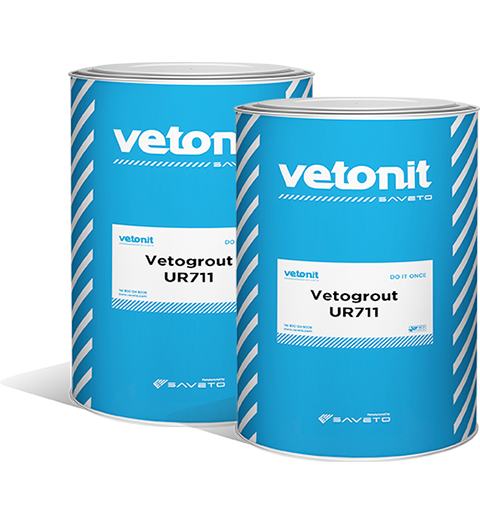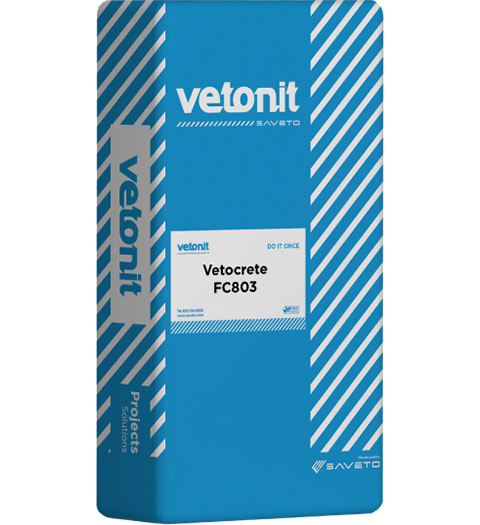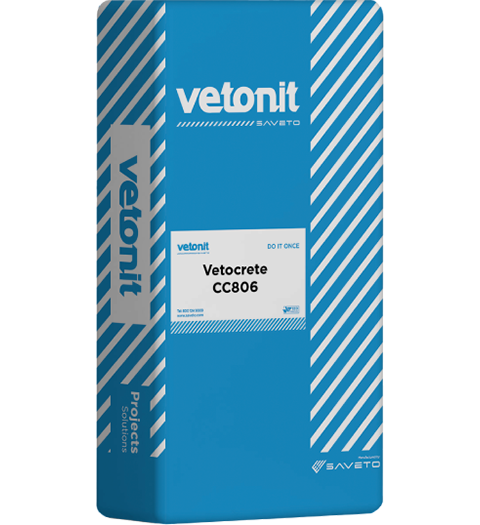Vetogrout UR711
Polyurethane injection resin (Non-foaming & flexible).
Vetogrout UR711 is a two-part solvent-free, low viscosity, polyurethane resin system. When mixed in the proportions supplied, it reacts to form a tough, slightly flexible resin. Vetogrout UR711 has good adhesion to concrete and masonry, and when injected into cracks, it allows some movement without loss of bond.
Vetogrout UR711 is used in conjunction with Vetogrout UR710 to form a permanent seal in cracked concrete.

Uses
- To form a flexible seal in concrete and masonry cracks.
- For crack injection in wet conditions (in conjunction with Vetogrout UR710).
- Crack injection in live crack cases.
Advantages
- Low viscosity with maximum crack penetration.
- Excellent adhesion to both dry and moist substrates.
- Flexible; it allows for movement accommodation in live cracks.
- Withstands high hydrostatic pressure.
- Impermeable.
Usage Instructions
Clean the surface and remove any dust, unsound or contaminated material, plaster, oil, paint, grease, corrosion deposits or algae. The surface should preferably be prepared using high pressure water jetting or light abrasive blasting, followed by thorough washing to remove dust and remaining particles.
Dirt alone may be removed with wire brushes or similar mechanical means. Oil and grease deposits should be removed by steam cleaning, detergent scrubbing or the use of a proprietary degreaser. The effectiveness of decontamination should be assessed by a pull-off test.
Blow cracks and treated surfaces with oil-free air to ensure complete removal of all dust and loose particles. Ensure that the surfaces are blown dry. In the presence of running water the flow must be stopped using Vetogrout UR710 which produces a rapid setting water-stopping foam (see separate data sheet). Reinject crack with Vetogrout UR711 when water has stopped.
All cracks must be sealed and injection packers located in place before Vetogrout UR711 is injected.
Fix the injection packers inserted into pre-drilled holes at intervals along the length of each crack. The distance between each packer will depend upon the width and depth of the crack. Spacing must be close enough to ensure that the resin will penetrate along the crack to the next point of injection. This will normally be between 200 mm & 500 mm. Seal the cracks’ surface between the packers with a band of Vetorep ER350 (30 mm - 40 mm wide. And 2 mm - 3 mm thick). Seal both sides of all cracks that penetrate through a wall or a slab.
In the case of a wall or slab which is cracked all the way through, packers must be located on both sides, those at the back should be placed midway between those at the front. Allow the Vetorep ER350 to cure for 8 hours at 35ºC. At low ambient temperature (5°C to 12°C), extend the curing time. Make sure that the surface sealant has adequately cured before continuing.
Attach one end of the injection hose to the lowest packer on vertical cracks or attach it to either end of horizontal cracks. Treat each crack in a single, continuous operation. Prepare sufficient material before you begin.
Mix the entire hardener and base resin contents thoroughly until the liquid becomes clear. Use Vetogrout UR711 with standard injection equipment (with closed containers). The injection pressure should be at least 0.4 N/mm2 (4 bar). Mix resin accurately so you can use it all within the pot life of the material.
Remove the packers or nipples. Make good any holes or voids with Vetorep ER350 and allow them to cure. The Vetorep ER350 can be ground off or softened with a blowlamp and peeled off. Do not allow to burn.
Remove Vetogrout UR711 and Vetorep ER350 from tools, equipment, and mixers with Vetonit Solvent XX400 immediately after use. Remove hardened material mechanically.









